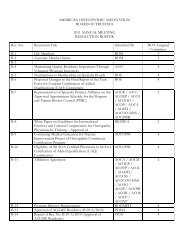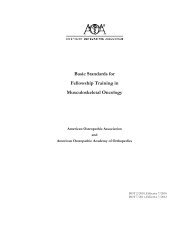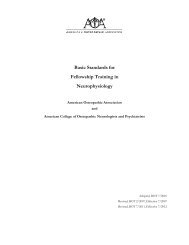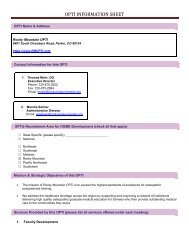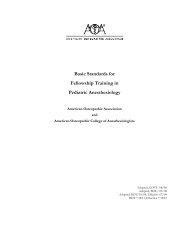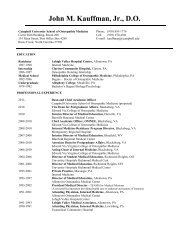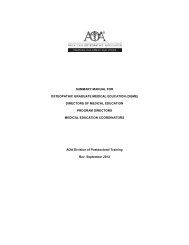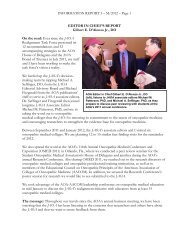Dialogue and Diagnosis - American Osteopathic Association
Dialogue and Diagnosis - American Osteopathic Association
Dialogue and Diagnosis - American Osteopathic Association
Create successful ePaper yourself
Turn your PDF publications into a flip-book with our unique Google optimized e-Paper software.
hips, which, with her excess weight,<br />
severely affect her mobility <strong>and</strong> even<br />
threatens the performance of routine<br />
activities of daily living. In addition,<br />
she has developed severe foot pain<br />
that occurs only at rest <strong>and</strong> affects<br />
her ability to sleep. This type of foot<br />
pain is often associated with diabetic<br />
neuropathy. The patient is generally<br />
adherent to her medication regimen,<br />
which consists of the following:<br />
—Metformin 2000 mg daily<br />
—Glimepiride 4 mg daily<br />
—Pioglitazone 15 mg daily<br />
Her current laboratory values are as<br />
follows:<br />
—HbA 1c 7.8%<br />
—FPG 139 mg/dL<br />
—PPG 189 mg/dL<br />
—Serum creatinine 1.2 mg/dL<br />
Discussion: Gloria is young <strong>and</strong><br />
healthy enough that a HgA 1c of 7%<br />
should be pursued. She is already on<br />
multiple oral antidiabetic medications.<br />
Metformin may be nearing the<br />
end of its usefulness in this patient, as<br />
her renal function is declining. Renal<br />
function is dynamic in patients with<br />
T2DM <strong>and</strong> requires close supervision,<br />
as do the choices of antidiabetic<br />
agents used in the patients. The Table<br />
summarizes the metabolism/<br />
clearance sites, with dosing adjust -<br />
ments in cases of chronic kidney<br />
disease, for commonly used medications<br />
in patients with T2DM, as<br />
adapted from Fonseca. 6<br />
Gloria’s renal function should<br />
continue to be monitored closely.<br />
Many physicians underestimate the<br />
importance of renal function in their<br />
patients with diabetes mellitus,<br />
assuming that it does not change<br />
rapidly in this patient group. This<br />
assumption potentially puts these<br />
individuals at risk of serious complications.<br />
With this consideration in<br />
Metabolism/<br />
Medication Clearance Site Dosing Adjustment/Notes<br />
Glinides Hepatic Decreased dose<br />
GLP-1 agonists<br />
—Exenatide Hepatic/renal Decreased dose<br />
—Liraglutide Hepatic/tissue Caution if prolonged nausea or<br />
vomiting<br />
Insulins Tissue/renal Decreased dose<br />
Metformin Renal Discontinue if creatinine³ 1.4 mg/dL<br />
in women,³ 1.5 mg/dL in men<br />
Sulfonylureas Hepatic/renal Glipizide preferred; glyburide has<br />
high risk of hypoglycemia; all need<br />
decreased dose<br />
Thiazolidinediones Hepatic No dose adjustment<br />
(eg, pioglitazone)<br />
Table. Metabolism <strong>and</strong> clearance sites, with dosing adjustments in cases of chronic<br />
kidney disease, for medications commonly used in patients with type 2 diabetes<br />
mellitus, as adapted from Fonseca. 6<br />
Abbreviation: GLP-1, glucagon-like peptide-1.<br />
mind, Gloria’s physician explained<br />
that they would need to adjust her<br />
therapy to keep her sugar levels in a<br />
safer range.<br />
A basal insulin was added to her<br />
regimen. Glargine insulin was started<br />
at a dose of 10 units to be adminis -<br />
tered daily at 10 p.m. The patient was<br />
instructed to check her FPG levels<br />
each day <strong>and</strong> to titrate her basal<br />
insulin dose based on an average of<br />
the last 3 FPG levels. If her FPG 3-day<br />
average was greater than 120 mg/dL,<br />
she was to increase her insulin<br />
glargine by 3-unit increments until<br />
an FPG level of 120 mg/dL was<br />
achieved.<br />
Insulin glargine titration<br />
continued according to schedule<br />
until Gloria’s FPG levels stabilized at<br />
or near 139 mg/dL. It seemed to<br />
Gloria that no matter what she did,<br />
adding more basal insulin did not<br />
cause her FPG level to change.<br />
When basal insulin is no<br />
longer sufficient<br />
Basal insulin analogs provide<br />
sustained background insulin levels<br />
for up to 24 hours in many, but not<br />
all patients. Longer-acting insulin<br />
analogs currently in development<br />
may be able to provide even more<br />
consistent <strong>and</strong> sustained levels in the<br />
majority of patients. 16 Basal insulin<br />
analogs have a flatter <strong>and</strong> more prolonged<br />
effect than NPH insulin. 13<br />
Increasing the basal insulin dose<br />
causes an approximately 0.5%<br />
decrease in HbA 1c level for each<br />
0.1 U/kg/day increment in insulin<br />
dose, up to a threshold of 0.5 U/kg.<br />
Beyond this dose, the improvement<br />
in HbA 1c reduction is less substantial,<br />
<strong>and</strong> the risk of hypoglycemia<br />
increases. 17 So at a dose of 0.5 U/kg it<br />
may be a good time for osteopathic<br />
physicians to reflect on additional<br />
treatment options rather than further<br />
titration of basal insulin.<br />
Most primary care providers have<br />
had to deal with this issue many<br />
times. Insulin resistance <strong>and</strong> -cell<br />
failure are common denominators in<br />
patients with T2DM. The balance<br />
may tip toward increasing -cell<br />
failure as the pathophysiologic<br />
features of T2DM progress <strong>and</strong> as FPG<br />
levels stop responding to basal<br />
insulin as glucose control is lost<br />
<strong>Dialogue</strong> <strong>and</strong> <strong>Diagnosis</strong> // September 2012<br />
25



